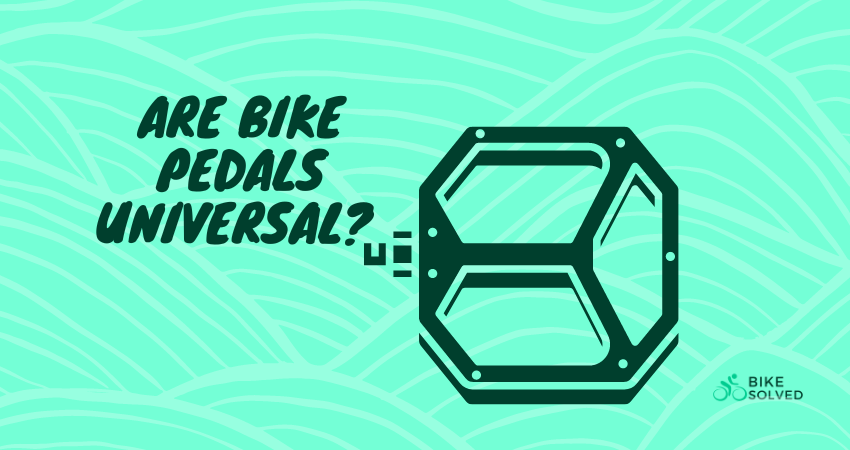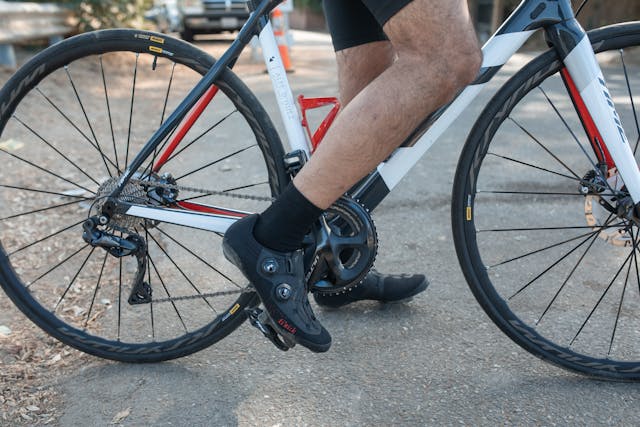Ever wondered if you can slap any awesome-looking pedals on your bike? Turns out, bike pedals aren’t always interchangeable. Don’t sweat it – I’ll clear up the confusion about bike pedal compatibility. Let’s break down whether bike pedals are universal and get you the right setup for the perfect ride.
Bikesolved.com is readers supported, you may find Amazon affiliated links on this page, that pays us commission for recommending products at no extra cost to you.
Are Bike Pedals Universal?
Unfortunately, there’s no simple “yes” answer to this question. While you’ll find a high degree of compatibility amongst adult bikes, there are still several factors that determine whether a specific pedal will suit your bike and riding style.
The first layer of compatibility has to do with the threaded connection between the pedal and your bike’s crank arms. The vast majority of modern adult bikes use the 9/16″ thread standard, making a wide range of pedals physically interchangeable. However, older bikes, some children’s models, and certain specialty bikes may use a different, 1/2″ thread size. If you’re unsure, check your bike’s specifications or consult your local bike shop.
Even if the pedal threading matches your bike, that’s only half the story. Pedal selection is also heavily influenced by your riding style. Clipless pedals, designed to lock into specialized cycling shoes, offer performance advantages for road cyclists and some mountain bikers.
Alternatively, flat platform pedals provide comfort and ease of use for casual riders and mountain bikers seeking maximum control on technical terrain. Each pedal category features variations that won’t necessarily be suited to different kinds of cycling.
So, why haven’t we achieved one universal pedal design? This stems from the specialized needs of different cycling disciplines. Road cyclists prioritize efficiency and power transfer, while mountain bikers might put durability and mud-shedding abilities at the top of their list. Furthermore, longstanding industry standards can influence design choices, even as bike technology continues to evolve.
Are All Bike Pedal Threads the Same Size?
Are all bike pedal threads the same size? No, not all bike pedal threads are the same size. The vast majority of modern bikes intended for adults use a 9/16″ thread size for their pedals, which means there’s a wide range of interchangeable pedal choices for riders of these bikes.
However, children’s bikes and some older models might use a 1/2″ thread size for their pedals. Smaller crank arms on these bikes mean the pedals don’t require the larger thread size, so it’s important to check if you’re looking to replace their pedals. While less common, certain vintage or specialty bikes might utilize unique pedal thread sizes that fall outside those two standards.
If you’re unsure about your bike’s pedal thread size, look for markings on your crank arm, consult your bike’s manual, or contact your local bike shop for assistance.
How to Identify Your Bike’s Pedal Size
While most modern adult bikes share a common thread size, it’s always best to verify before swapping out pedals. Here’s how to determine your bike’s specific pedal size:
-
-
Check Your Bike’s Specifications: If you still have the owner’s manual or online specifications for your bike, the pedal thread size will usually be listed. This is the quickest and easiest option if the information is readily available.
-
-
-
Look for Markings on the Crank Arm: Inspect the end of your crank arm. This is the metal arm that connects your pedals to the bike. In some cases, the pedal thread size (either 9/16″ or 1/2″) will be directly stamped onto the metal.
-
-
-
Measuring Tools: If visuals fail, you can use a few household tools for a more precise approach:
-
- Ruler or Tape Measure: For a rough estimate, try measuring across the diameter of the threaded hole in your crank arm. For 9/16″ it should be roughly 9/16 of an inch across, with 1/2″ size naturally measuring closer to a half-inch.
-
- Calipers: For the most accurate method, a set of calipers can precisely measure the diameter of the pedal threads. If your measurements are consistently around 0.56″, this indicates a 9/16″ size. A half-inch measurement points towards a 1/2″ thread size.
-
-
-
-
The Old “Try It” Method: This is only feasible if you already have spare pedals to test with. Carefully attempt threading the other set of pedals into your crank arm. If it begins to screw in smoothly, you likely have a match. This approach is generally a last resort, as improperly sized pedals can damage your crank arm threads.
-
-
-
Seek Professional Help: If you’re still uncertain or suspect you might be working with a non-standard setup, it’s always best to consult with your local bike shop. Bike mechanics have the tools and expertise to quickly identify your specific pedal thread size without any guesswork.
-
FAQs
Can bike pedals fit any bike?
Not all bike pedals are universally compatible. While most adult bikes share the same thread size, you’ll need to consider whether the type of pedal (flat, clipless, etc.) is ideal for your style of riding. Older bikes and children’s bikes might also have different thread sizes.
How do you tell if my pedals are 1/2 or 9/16?
-
- Visual Check: Look for markings stamped on the end of your crank arm (where the pedal connects).
-
- Ruler/Tape Measure: Roughly measure the diameter of the threaded hole: 1/2″ will be closer to half an inch across, while 9/16″ will be slightly smaller.
-
- Calipers: For precise accuracy, use calipers to measure the thread diameter.
Can I change my own bike pedals?
Yes, you can change your own bike pedals with a few basic tools (pedal wrench or standard wrench). Remember, pedal threads are directional: the left pedal tightens counter-clockwise, and the right pedal tightens clockwise.



